|
Have a safe day!
Thursday, March 25
2:30 p.m.
Theoretical Physics Seminar - Curia II
Speaker: Enrico Lunghi, Indiana University, Bloomington
Title: High Precision Flavor Physics
3:30 p.m.
DIRECTOR'S COFFEE BREAK - 2nd Flr X-Over
4 p.m.
Accelerator Physics and Technology Seminar - Curia II (NOTE LOCATION)
Speaker: Alberto Gola, Politecnico di Milano
Title: Design of an SDD-Based Gamma Camera: Detector, Front-End and Signal Processing
Friday, March 26
3:30 p.m.
DIRECTOR'S COFFEE BREAK - 2nd Flr X-Over
THERE WILL BE NO JOINT EXPERIMENTAL-THEORETICAL PHYSICS SEMINAR THIS WEEK
Click here for NALCAL,
a weekly calendar with links to additional information.
Upcoming conferences |
|
For information about H1N1, visit Fermilab's flu information site.
|
|
Thursday, March 25
- Apple sticks
- Southwestern chicken tortilla
- Philly style cheese steak
- *Garlic herb roasted pork
- Mardi Gras jambalaya
- *Southwestern turkey wrap
- Assorted sliced pizza
- *Marinated grilled chicken caesar salads
*Carb restricted alternative
Wilson Hall Cafe Menu
|
|
Thursday, March 25
Dinner
- Closed
Wednesday, March 31
Lunch
- Chicken w/lime sauce
- Cumin roasted potatoes
- Sautéed zucchini
- Chocolate raspberry cake
Chez Leon Menu
Call x3524 to make your reservation.
|
|
|
High rise lights go out for Earth Hour
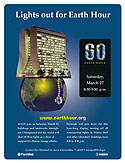 |
| Fermilab will shut off all nonessential lights in Wilson Hall between 8:30-9:30 p.m. Saturday, March 27, as part of Earth Hour. |
Fermilab's Wilson Hall stands 16 stories above the surrounding prairie, serving as a beacon for the northwestern suburbs.
For one hour on Saturday, March 27, the building will boost its energy conservation efforts by joining businesses, organizations and homes around the world in darkness.
Earth Hour, a global 60 minutes without electricity, delivers a powerful message about the need for action to pull the plug on global warming.
"Earth Hour is a simple act that gives us an opportunity to think about the way we consume energy and the impact of how we use energy on the environment," said Eric Mieland, an environmental specialist at Fermilab.
All nonessential lights in Wilson Hall will shut off at 8:30 p.m. Lights necessary for safety, such as those in stairwells, and those needed to run experiments will remain on. Those who need to work on Saturday night should try to do so before or after 8:30-9:30 p.m. If you must work during that time, please remember to switch lights off when done. As an extra measure of compliance, all nonessential lights switched on after 8:30 p.m. will shut off again at midnight.
Wilson Hall building manager John Kent hopes that employees will do their part by turning off personal computers, task lights or any other personal electronics before leaving for the weekend.
In a 2009 press release, Commonwealth Edison, the electric company that provides power to Chicago and northern Illinois, said that the Earth Hour event cut the metropolitan area's energy consumption by an estimated 100 megawatt hours, the equivalent of removing 154,500 pounds of carbon dioxide from the atmosphere or planting 19 acres of trees.
Already this year, thousands of cities in 120 countries have signed on to participate in this year's event.
For more information on Earth Hour, visit www.earthhour.org. Contact Eric Mieland, x2248, mieland@fnal.gov, with questions.
-- Rhianna Wisniewski
|
Service awards
On Jan. 29, 2010, service awards were given out for 10, 20, 25, 30, 35 and 40 years of service to the laboratory. The laboratory did not give out any service awards during 2008, when furloughs made getting people together difficult, and is catching up on these awards now.
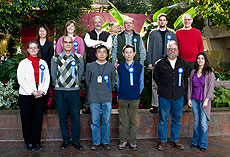
10 Year Service Award: Row 1 from left: Karen Seifrid, Cristinel Gingu, Taka Yasuda, Dehong Zhang, Rich Bergquist and Diana Canzone.
Row 2 from left: Young-Kee Kim (Directorate), Katie Kosirog, Pier Oddone (Directorate), Sali Sylejmani, Jamie Blowers and Bruce Chrisman (Directorate).
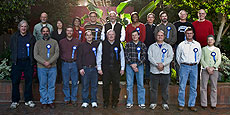
20 Year Service Award: Row 1 from left: Steve Hahn, Alan Hahn, Thomas Kroc, Russell Rucinski, Byron Clark, Daniel Klepec, C.D. Andrews, Mark Thompson and Karen Shepelak.
Row 2 from left: Dan Stenman, Young-Kee Kim (Directorate), Pushpa Bhat, Michael Geynisman, Pier Oddone (Directorate), Etta Burns, Peter Prieto, Terrance Jones, Michael Foley and Bruce Chrisman (Directorate).
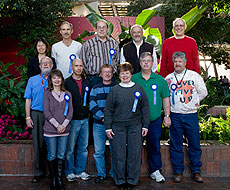
25 Year Service Award: Row 1 from left: Linda Bagby and Joanne Hall. Row 2 from left: Peter Lucas, Patrick Sheahan, Rich Thompson, Brian Fellenz and B. Todd Wagner. Row 3 from left: Young-Kee Kim (Directorate), Tom Zimmerman, Mike Behnke, Pier Oddone (Directorate) and Bruce Chrisman (Directorate).
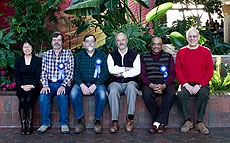
30 Year Service Award: Row 1 from left: Young-Kee Kim (Directorate), James Schellpfeffer, Peter Seifrid, Pier Oddone (Directorate), Larry Bradley and Bruce Chrisman (Directorate).
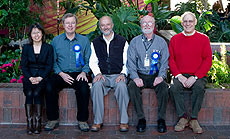
35 Year Service Award: Row 1 from left: Young-Kee Kim (Directorate), Don Rohde, Pier Oddone (Directorate), Gerald Bellendir and Bruce Chrisman (Directorate).
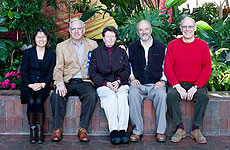
40 Year Service Award: Row 1 from left: Young-Kee Kim (Directorate), Chuck Schmidt and his wife, Judy, Pier Oddone (Directorate) and Bruce Chrisman (Directorate).
|
Fermilab gives new challenges a whirl
From Chicago Tribune, March 24, 2010
European collider packs more wallop, but Tevatron still stirs up particle race
In a week or so, scientists at a 17-mile underground loop on the Swiss-French border are expected to collide protons at an unprecedented force, about three times the energy applied to protons at Fermilab, the national physics laboratory in Batavia.
It might sound a bit removed from the everyday concerns of a sputtering economy and health care reform, except for one thing: The future of the U.S. global leadership in particle physics may hinge on what happens in that area between Switzerland's Lake Geneva and France's Jura mountains over the next few years.
That has left Fermilab in the somewhat uncomfortable spot of being second banana, a status that has scientific and academic consequences. Yet, it has several projects in development and is pursuing the so-called "God particle" - the Holy Grail of particle physics.
Read more
|
|
|
Studying the heaviest quark using the lightest leptons
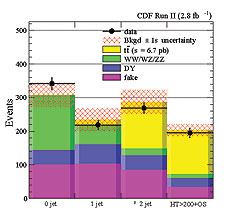 |
| Dilepton candidate events (black point) are shown by jet multiplicity. The stacked histogram represents the background contribution and the top pair (tt) expectation. The hatched area represents the uncertainty in the total background estimate. |
Scientists can count the production rate of the top quark, the heaviest-known elementary particle created at the Tevatron, by using the lightest elementary particles: electrons, muons and neutrinos. They can do this by examining the decay products of the top quark pair.
The dilepton decay mode occurs when the W bosons created in top quark disintegrations further decay into a charged lepton (electron or muon) and a neutrino. This dilepton final state is rare — only 4.9 percent of top pairs decay this way — but it is the easiest to identify because not very many other processes can produce such a striking final state. This state includes two high-energy leptons, a large missing energy from the neutrinos, and two high-energy jets from the b quarks produced with the W in the top decay.
Early in Run II (2004), scientists at CDF reported on a dilepton sample with only 13 candidate events. In a recently submitted paper, they updated that measurement with more than 10 times the data sample -- 195 candidate events.
CDF scientists check the understanding of the backgrounds in an independent data sample by looking for events that contain two leptons and large missing energy but no jets. By not including jets, they insure that the sample has very few top pair events and scientists can therefore use it to study the background processes.
The recent results are shown in the above figure, which shows that the CDF scientists can accurately predict the dilepton and missing energy signature for all cases: no jets, one jet, two or more jets, or two or more jets plus additional requirements used to purify the signal of the top quark pair.
The final result is a measurement of the rate of the top pair production, i.e. cross section, of 6.27 ± 0.73(stat) ± 0.63(syst) ± 0.39 (luminosity) picobarns, which is in good agreement with theoretical predictions.
-- edited by Craig Group
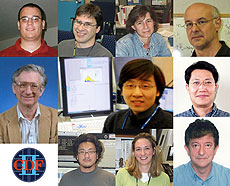 |
| David Mietlicki, Alexei Varganov, Monica Tecchio and Dan Amidei, University of Michigan. Middle row: Andy Beretvas, Fermilab; Chang-Seong Moon and Soo-Bong Kim, Seoul National University, Korea. Bottom Row: Naoki Kimura, Waseda Uniersity, Japan; and Victoria Giakoumopoulou and Nikos Giokaris, University of Athens, Greece.
|
|
In search of an elusive particle
From Vancouver Sun, March 24, 2010
Canadian physicist hopes camera in Large Hadron Collider can record magnetic monopole
A Canadian researcher and an international team of experts are searching once again for an elusive particle -- one that high school physics textbooks say doesn't exist.
They've set up a camera at the Large Hadron Collider -- the particle accelerator built 100 metres beneath the Franco-Swiss border -- and are hoping one of the collisions created in the accelerator will solve the mystery.
It could create a magnetic monopole -- a magnetic particle with only one pole -- which numerous theories predict should exist but has never been found before.
The camera is now sitting in the accelerator beneath the international airport in Geneva.
Next December, physicist Jim Pinfold of the University of Alberta and his team will take the layers of plastic film of the camera back out, and if any monopoles were created, their mark should be clear.
Read more
|
|